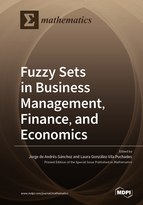Fuzzy Sets in Business Management, Finance, and Economics
A special issue of Mathematics (ISSN 2227-7390). This special issue belongs to the section "Fuzzy Sets, Systems and Decision Making".
Deadline for manuscript submissions: closed (30 December 2021) | Viewed by 39313
Special Issue Editors
Interests: fuzzy sets; fuzzy data analysis; actuarial modeling; social inequality policies
Special Issues, Collections and Topics in MDPI journals
Interests: fuzzy set theory applications on finance and insurance; actuarial and uncertainty modeling
Special Issues, Collections and Topics in MDPI journals
Special Issue Information
Dear Colleagues,
Since the publication of Lotfi A. Zadeh’s seminal paper “Fuzzy Sets” in 1965 in the journal Information and Control, there has been a constant growth in theoretical developments and practical applications of fuzzy set theory and related mathematical tools. These tools have been widely applied, both in industry and academic research, to decision making and economics due to their versatility. On the one hand, they can efficiently represent and handle uncertain and vague information as subjective judgements, non-precise observations on variables or ill-defined relations between variables. On the other hand, they make implementing computations or identifying patterns in data much easier. To do so, fuzzy set theory provides a lot of mathematical techniques in fields such as expert systems, soft computing, data analysis, mathematical programming or multiple criteria decision making. Asset pricing, portfolio selection, actuarial modeling or capital budgeting problems are some examples of practical applications in these fields. This Special Issue provides a platform for researchers from academia and industry to present their novel and unpublished works in the domain of applied developments of fuzzy sets and related methodologies to business, financial, and economic analysis. This will help to foster future research in the emerging fields of economics and social sciences.
Dr. Jorge de Andres Sanchez
Dr. Laura González-Vila Puchades
Guest Editors
Manuscript Submission Information
Manuscripts should be submitted online at www.mdpi.com by registering and logging in to this website. Once you are registered, click here to go to the submission form. Manuscripts can be submitted until the deadline. All submissions that pass pre-check are peer-reviewed. Accepted papers will be published continuously in the journal (as soon as accepted) and will be listed together on the special issue website. Research articles, review articles as well as short communications are invited. For planned papers, a title and short abstract (about 100 words) can be sent to the Editorial Office for announcement on this website.
Submitted manuscripts should not have been published previously, nor be under consideration for publication elsewhere (except conference proceedings papers). All manuscripts are thoroughly refereed through a single-blind peer-review process. A guide for authors and other relevant information for submission of manuscripts is available on the Instructions for Authors page. Mathematics is an international peer-reviewed open access semimonthly journal published by MDPI.
Please visit the Instructions for Authors page before submitting a manuscript. The Article Processing Charge (APC) for publication in this open access journal is 2600 CHF (Swiss Francs). Submitted papers should be well formatted and use good English. Authors may use MDPI's English editing service prior to publication or during author revisions.
Keywords
- fuzzy reasoning
- soft computing
- fuzzy data analysis
- mathematical programming
- multiple criteria decision making
- expert systems
- fuzzy neural systems
- fuzzy game theory
- intuitionistic and neutrosophic sets
- fuzzy modeling in economics
- business management and finance







